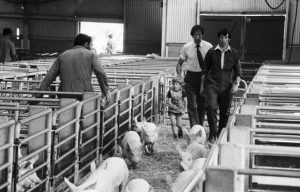A history of the company that founded Bury St Edmunds Cattle Markets and which may have helped solve the identity of Jack the Ripper, will be displayed at Moyseâs Hall Museum this month.
Henry Lacy Scott founded his auctioneer business in 1869 and started up a Cattle Market five years later. Over the years the business diversified and became Lacy Scott and Knight.
The popular Cattle Market survived the swine fever outbreak of the 1920s and fowl plague in the 1960s but the Bovine Spongiform Encephalitis outbreak of the 1990s saw that particular side of the business dwindle and the last Cattle Market in Bury St Edmunds was held in 1998.
Now 21-year-on, its history will be celebrated at Moyseâs Hall Museum later this month to mark 150-years of Lacy Scott and Knight.
Cllr Joanna Rayner, Cabinet Member for Leisure and Culture at St Edmundsbury Borough Council said: âFor over 100 years the Cattle Market was part of the townâs history. Many people remember coming to town to see the animals with fondness today. Lacy Scott and Knight are a key part of that story and we look forward to celebrating their 150 year history at Moyseâs Hall Museum.â
Ed Crichton, partner at Lacy Scott and Knight said: âIn our 150th anniversary year, we are pleased to announce a mini-display charting our company history at Moyseâs Hall Museum. It will include items donated to the museum by the Lacy Scott family, photographs of the last cattle market held in the town, information and highlights from our 150 years as auctioneers, and a stunning medieval stirrup ring which the museum has acquired through a charitable donation by Lacy Scott and Knight.â
The exhibition will also feature the Victorian gavel and other personal items that belonged to Henry Lacy Scott, old photographs, sale catalogues and a silver trophy presented to Walton Burrell in 1882 for Best Ox.
Not all the items are about the Cattle Market â a digital history of the company includes the sale of the Bury St Edmunds workhouse in College Street in 1884, as well as its sale of a blood stained Victorian shawl in 2007. That shawl was said to have belonged to ripper victim Catherine Eddowes. Seven years after the sale its buyer released a book claiming that DNA testing of the shawl had revealed that the Ripperâs true identity as Aaron Kosminski, one of the chief police suspects at the time.
The Lacy Scott and Knight display will be on at the museum from 13 March to 11 April. For more information visit www.moyseshall.org


